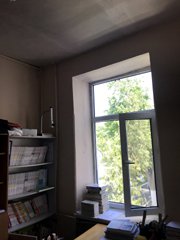Supporting the Present while Looking 10–20 Years Ahead
Dovletmammet Azadi Turkmen National Institute of World Languages/
National Institute of Education of Turkmenistan
SATO Goro
The Japanese-Language Senior Specialists (hereinafter “Senior Specialists”) and Japanese-Language Assistants who are dispatched to Turkmenistan are assigned to two institutions: the Dovletmammet Azadi Turkmen National Institute of World Languages (hereinafter “Azadi Institute”) and the National Institute of Education of Turkmenistan. This report will focus on the work we do at the Azadi Institute.

The main building of the Azadi Institute
1. Overview of the Azadi Institute’s Japanese Language Specialty and its Challenges
The Azadi Institute is an institute for foreign languages that offers 12 language specialties, including English; its Japanese Language Specialty was established in 2007. Since then, during the ten years until the launch of Japanese-language education in six other universities in 2016, the Azadi Institute was the only Japanese-language educational institution in the country. Even today, this is the only higher educational institution in which students can study Japanese as a specialty, and many of its graduates work as Japanese teachers in primary and secondary educational institutions and universities. Consequently, this Azadi Institute plays a key role in training Japanese teachers for the future.
However, I have to say that the Specialty’s foundations are still fragile. The Specialty has not set targets to be reached by graduation, and the subject content and textbooks used have changed every year. As a result, the level that the students attain when they graduate has varied year on year. As I have said, many graduates become teachers, and so the difference in their Japanese levels depending on the year is not a good thing. In addition, the Turkmen teachers only considered their own classes, and have tended to be blind to the links between different subjects and connections between academic years. In other words, they were acting separately despite belonging to the same specialty.
Consequently, we have started the following initiatives to solve these issues and ensure that the students reach a certain standard.
(1) Teaching Together
According to the timetable created by the Azadi Institute, one subject is fundamentally taught by one lecturer. However, when this is implemented, there is a direct connection between the lecturer’s capabilities and student understanding and retention, especially in subjects that have a lot of classes. In addition, it is conceivable that there are actually more demerits to having just one lecturer teaching, due to the issue of compatibility between people.
The Turkmen lecturers who had been teaching alone until now were not used to following a progress plan, and at first, they taught two or three lessons’ worth of content at once, or forgot that another teacher would be taking over, but after a month had passed, they adapted to this way of doing things, and handing things over is now part of their everyday work.
(2) Making Decisions with Everyone
When one subject was taught by one person, the content and the textbook were also decided by the teacher in charge of that class. However, the reasoning behind these decisions was “because the students said they wanted to learn it,” and “because this textbook has been used before,” etc.—they apparently didn't consider what skills the students would gain through that subject. In addition, classes often started trying to use a textbook, but found that it wasn’t as easy to use as they thought, or it didn't match the students’ level, and so the textbook was changed part of the way through the class.

A Japanese-language lecturer room
We therefore held a teacher meeting before the start of the semester, and decided on the content and textbooks to use for each subject by discussing them together. At the meeting, we first looked over all the academic years, and selected content that students can study with a good balance between the four skills (listening, speaking, reading, and writing), or decided with just the right number of subjects on Japanese-language studies and subjects on Japanese-language education. We then considered the students’ levels, and chose appropriate textbooks. With these decisions made with careful thought for the first time, the classes were successful right up to the end, with no confusion or anyone becoming dispirited during the semester. The students also seem to be gaining suitable skills.
After the semester finished, we held another meeting, and everyone shared the progress of each subject and the students’ attainment levels.
On top of this, the teachers gave tests on the lessons according to the textbooks and adopted a weekly composition lesson, establishing what should be learnt through new initiatives and improving the students’ levels. We are now moving forward with preparations to decide attainment levels for graduation and for each year by using the CEFR (Common European Framework of Reference for Languages).
2. Looking 10–20 Years into the Future
These practices are not showy or novel; they’re simple, and no more than common sense to many teachers. Still, they are necessary for the Azadi Institute to create a foundation for its specialty. It will probably take several years to establish our current initiatives among the Turkmen teachers, and an even longer period of time will be needed until the specialty has a system in place.
A lot of things are not going as we thought they would, but I want to continue providing the necessary support for the future now, without hurrying the results.
- What We Do Top
- Arts and Cultural Exchange [Culture]
- Japanese-Language Education Overseas [Language]
- Japanese-Language Education Overseas [Language] Top
- Learn Japanese-language
- Teach Japanese-language
- Take Japanese-Language Test
- Know about Japanese-language education abroad
- The Japanese-Language Institute, Urawa
- The Japanese-Language Institute, Kansai
- Japanese-Language Programs for Foreign Specified Skilled Worker Candidates
- Japanese Language Education for Japanese Children Resident Overseas and for the Descendants of Migrants
- Archives
- Japanese Studies and Global Partnerships [Dialogue]
- JF digital collection
- Other Programs / Programs to Commemorate Exchange Year
- Awards and Prizes
- Publications
